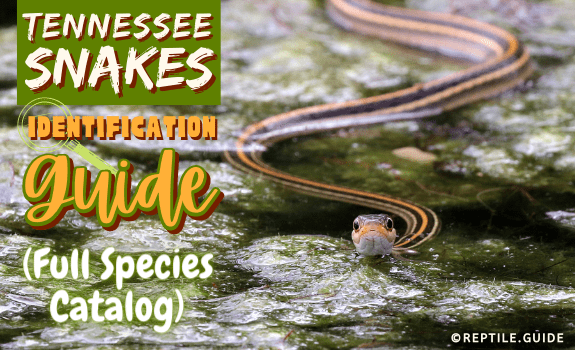Tennessee snakes come in many shapes and sizes. Big, small, colorful, bland, this state has them all.
From the harmless rat snake in Tennessee to the venomous (mistakenly called poisonous) snakes in Tennessee.
In this article, we’ll take a look at:
- Common venomous snakes
- How to identify Tennessee snakes
- How to deal with snakes if you find them
- Iconic snake species that live in Tennessee
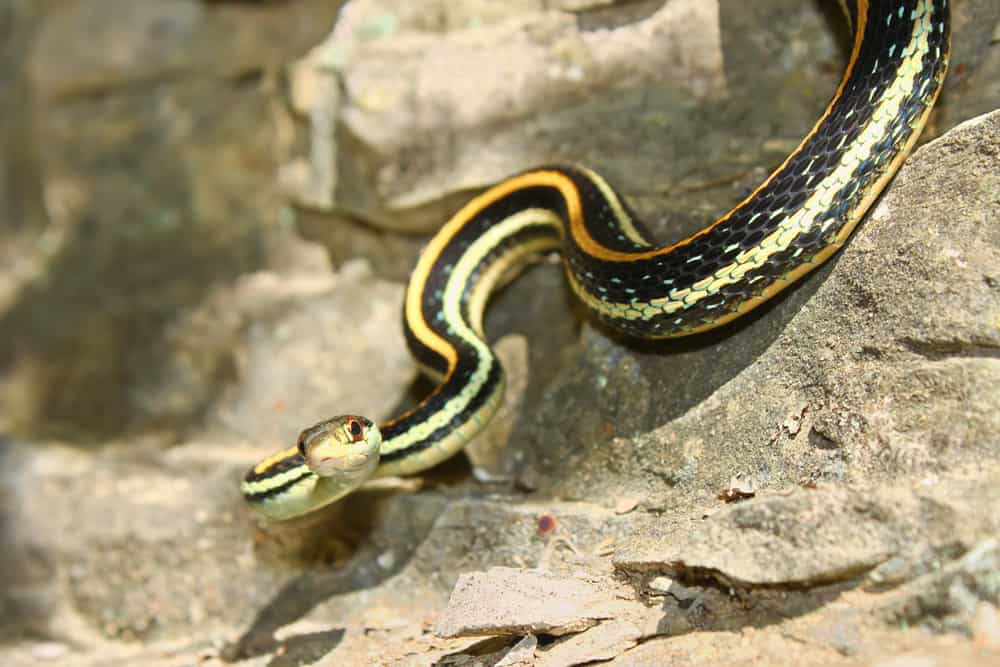
We’ll also share some pictures of snakes in Tennessee.
In This Article
Snake Identification Basics
When trying to identify a snake, there are a few things you need to look out for:
- Length
- Habitat
- Location
- Pupil and head shape
- Coloration and patterning
Alone, none of these things are likely to give you a concrete result. However, by combining several of them, you should be able to ID the snake.
For example, if you’re trying to identify snakes in East Tennessee, you can easily discount snakes that only live in the Western counties.
If the snake is over five feet long, you can discount species like the worm snake that only reaches short lengths.
Pit vipers like rattlesnakes and copperheads have slit-shaped eyes and broad flat heads.
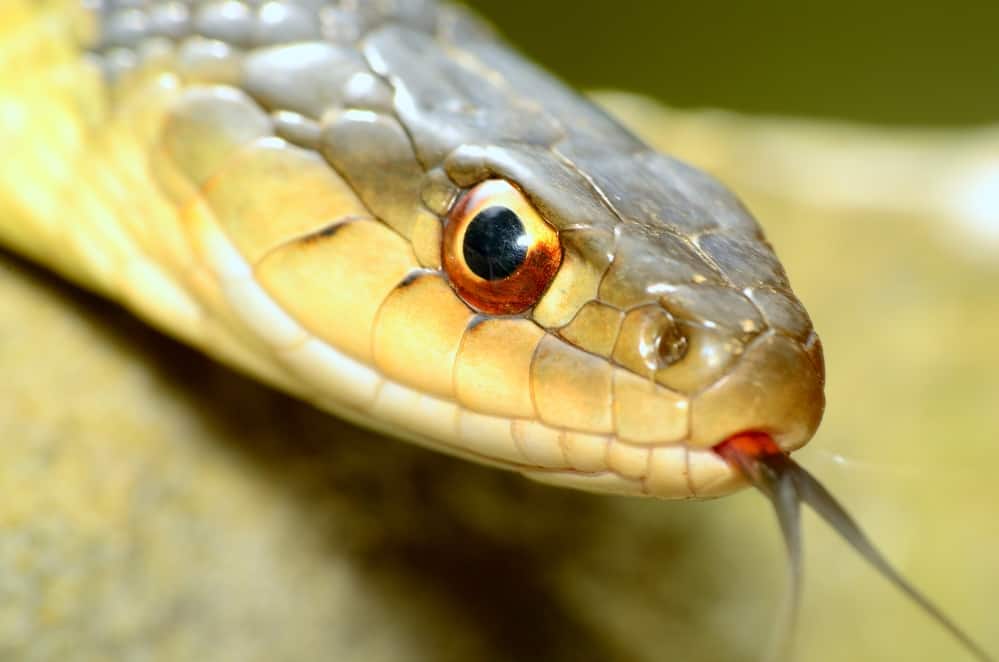
This sets them apart from snake species like the Southeastern crowned snake.
A brightly colored snake like the scarletsnake definitely can’t be a timber rattlesnake.
By following a process of elimination you’ll soon have an identification of what the snake is.
Sites like iNaturalist can help you learn more about identifying native snake species and getting a confirmation for your identification.
Quickly Identifying a Venomous Snake
Identifying venomous snakes in Tennessee is a relatively easy process.
The pit vipers make up all four species, with no other venomous snakes in the region.
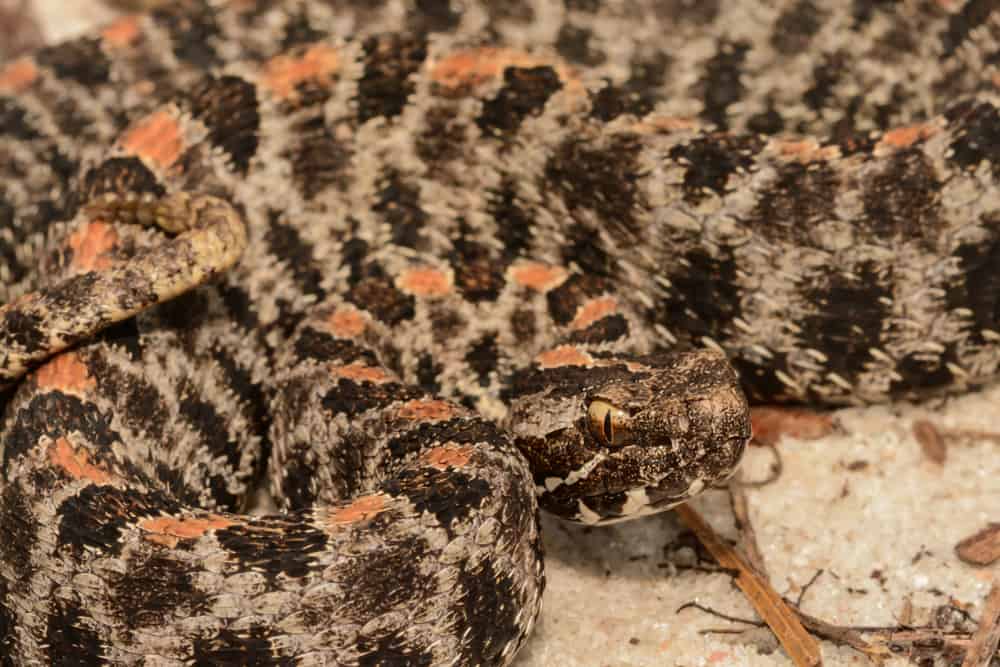
Several traits set vipers apart from the non-venomous species in the area, namely:
- Heat-sensing pits between the eyes and nostrils.
- Slit-shaped pupils and broad, shield-shaped heads.
- Modified tale scales (in the rattlesnakes) that make a hissing sound.
- Stocky bodies, considerably broader than many snakes in the region.
The hog-nosed snake is the only non-venomous snake species that you might confuse for a pit viper.
However, it lacks heat-sensing pits, has different coloration, and its head is much flatter.
Which Snakes Live in Tennessee?
The Tennessee government website lists 32 different snake species in the region. All of the following groups of species occur in Tennessee:
Pit Vipers
-
- Pygmy Rattlesnake – Sistrurus miliarius
- Timber Rattlesnake – Crotalus horridus
- Eastern Copperhead – Agkistrodon contortrix
- Northern Cottonmouth – Agkistrodon piscivorus
Kingsnakes
-
- Black Kingsnake – Lampropeltis nigra
- Prairie Kingsnake – Lampropeltis calligaster
- Scarlet Kingsnake – Lampropeltis elapsoides
- Eastern Milksnake – Lampropeltis triangulum
- Eastern Kingsnake – Lampropeltis getula
- Speckled Kingsnake – Lampropeltis holbrooki
Watersnakes
-
- Banded Watersnake – Nerodia fasciata
- Common Watersnake – Nerodia sipedon
- Plain-bellied Watersnake – Nerodia erythrogaster
- Diamondback Watersnake – Nerodia rhombifer
Brownsnakes
-
- Red-bellied Snake – Storeria oipitomaculata
- Dekay’s Brownsnake – Storeria dekayi
Garter Snakes
-
- Ribbon Snake – Thamnophis saurita
- Western Ribbon Snake – Thamnophis proximus
- Common Garter Snake – Thamnophis sirtalis
Corn and ratsnakes
-
- Corn Snake – Pantherophis guttatus
- Gray Ratsnake – Pantherophis spiloides
- Eastern Ratsnake – Pantherophis alleghaniensis
The rest of the species are all single representatives of their genera:
- Mudsnake – Farancia abacura
- Pine Snake – Pituophis melanoleucus
- Queensnake – Regina septemvittata
- Scarletsnake – Cemophora coinea
- Rough Earthsnake – Haldea striatula
- Rough Greensnake – Opheodrys aestivus
- Smooth Earthsnake – Virginia valeriae
- Ring-necked Snake – Diadophis punctatus
- Eastern Worm Snake – Carphophis amoenus
- North American Racer – Coluber constrictor
- Eastern Hognose Snake – Heterodon platirhinos
- Southeastern Crowned Snake – Tantilla coronata
Most Common Snakes in Tennessee
We’ve combed websites like iNaturalist to find the most common snakes in Tennessee. The most commonly observed snakes include:
- Gray Ratsnake – Pantherophis spiloides
- Common Watersnake – Nerodia sipedon
- Common Garter Snake – Thamnophis sirtalis
- Ring-necked Snake – Diadophis punctatus
- Black Kingsnake – Lampropeltis nigra
We’ll take a closer look at these non-venomous snakes, and their close relatives, in the next few sections.
Rat Snakes and Corn Snakes – Pantherophis
Rat snakes are some of the most common non-venomous snakes found in this region.
Several pet snakes, including the corn snake, are rat snakes. These snakes take well to living alongside humans and have calm personalities.
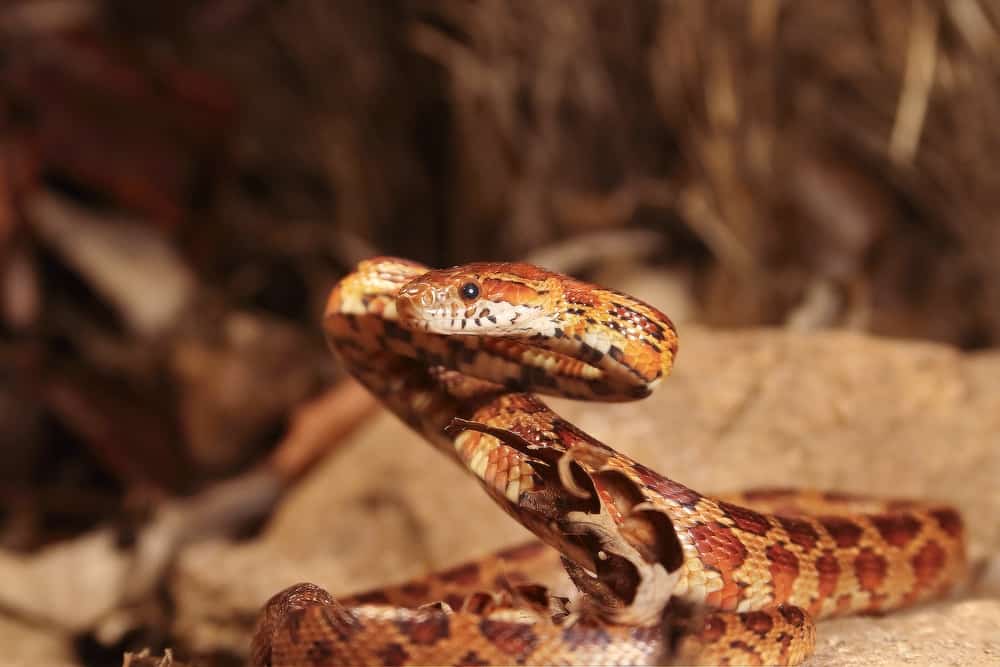
|
Scientific Name: |
Genus: Pantherophis Species:
|
|---|---|
|
Range: |
Throughout Tennessee |
|
Adult Size: |
Averaging three to six feet |
|
Description: |
Long slender snakes with a wide array of colors and patterns Colors range from brown to black and red Elongated heads and round pupils |
|
Habitat: |
Complete generalists, preferring areas with plenty of cover |
|
Venomous/Non-Venomous: |
Non-venomous |
Water Snakes in Tennessee – Nerodia
The water snake is a common non-venomous snake found near swamps and other water sources.
Water snakes in Tennessee feed on fish, frogs, and other animals attracted to the water. They’re completely harmless.
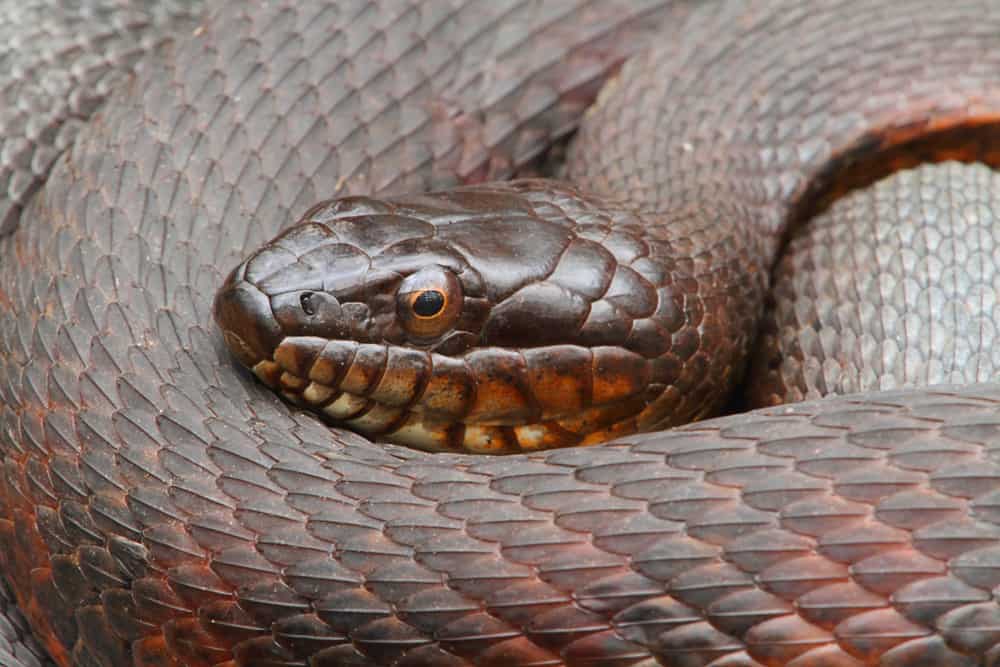
|
Scientific Name: |
Genus: Nerodia Species:
|
|---|---|
|
Range: |
Throughout Tennessee |
|
Adult Size: |
Averaging three to five feet |
|
Description: |
Robust snakes with prominent heads that feature many glossy scales Diamond-shaped scales and round pupils |
|
Habitat: |
Anywhere near fresh water Often found near swamps and marshes |
|
Venomous/Non-Venomous: |
Non-venomous |
Garter Snakes – Thamnophis
Garter snakes are common visitors to homes and gardens. They’re entirely harmless, and help to control pest populations.
These animals are attracted to the rodent populations that invariably spring up around human habitations.
They accidentally enter homes through windows and often find themselves trapped there.
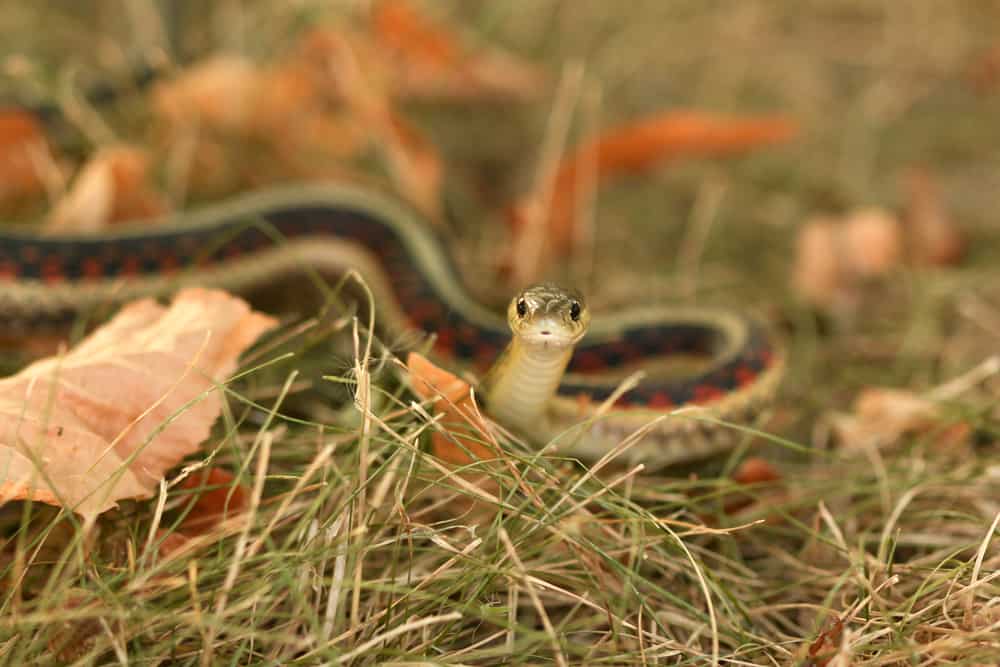
|
Scientific Name: |
Genus: Thamnophis Species:
|
|---|---|
|
Range: |
Throughout Tennessee |
|
Adult Size: |
Averages 18 to 26 inches |
|
Description: |
Long thin snakes with bright orange tongues and round pupils These snakes are usually brown with a vertebral stripe, or several vertebral stripes, in shades of brown or black |
|
Habitat: |
Generalists, invading any food-rich habitat Often enters houses accidentally |
|
Venomous/Non-Venomous: |
Non-venomous |
Kingsnakes – Lampropeltis
Kingsnakes are harmless snakes with placid personalities. Several of them, like the milk snake and black kingsnake, are popular pet snakes.
They’re habitat generalists, and it’s not uncommon to see them around human habitations.
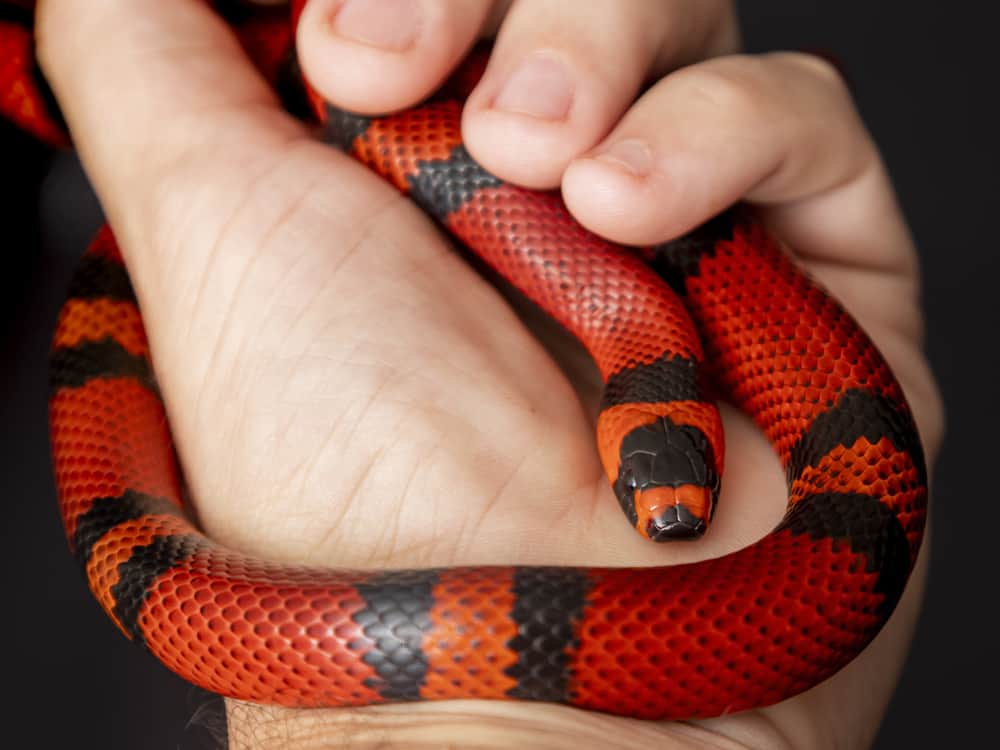
|
Scientific Name: |
Genus: Lampropeltis Species:
|
|---|---|
|
Range: |
Throughout the state |
|
Adult Size: |
Averages 36 to 60 inches |
|
Description: |
Long snakes with relatively muscular bodies Colors range from brown to black or red Bullet-shaped heads with round pupils |
|
Habitat: |
Habitat generalists that will live in just about any habitat where food is abundant Often prairies or forests near swamps and marshes |
|
Venomous/Non-Venomous: |
Non-venomous |
Ring-necked Snakes – Diadophis punctatus
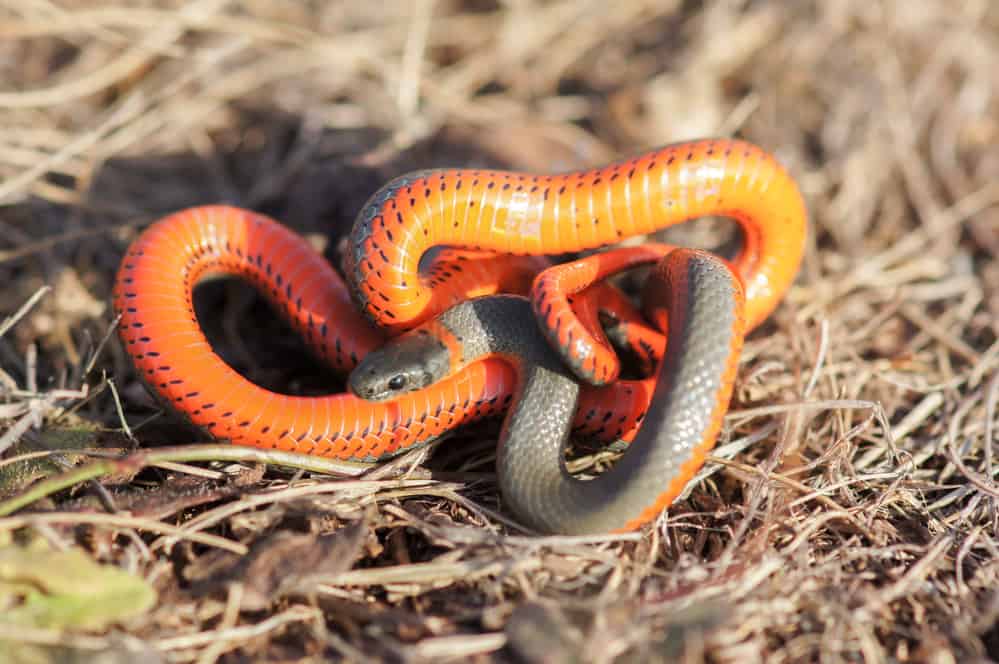
The ring-necked snake is a beautiful red-bellied snake with a black or brown dorsal surface.
These nonvenomous snakes trick predators into thinking they’re dangerous by flashing the bright colors on their undersides.
|
Scientific Name: |
Diadophis punctatus |
|---|---|
|
Range: |
Throughout Tennessee |
|
Adult Size: |
Averages 10 to 15 inches |
|
Description: |
A relatively small, stocky snake Black with a red or orange belly Rounded head with circular pupils |
|
Habitat: |
Areas with soft, moist soil |
|
Venomous/Non-Venomous: |
Non-venomous |
Venomous Snakes in Tennessee
There are very few venomous snakes in Tennessee, and all four species are pit vipers. Let’s take a closer look at each of them.
Timber Rattlesnakes
The timber rattlesnake is the largest rattler in Tennessee. It gets its name from its preferred habitat of forests and woodlands.
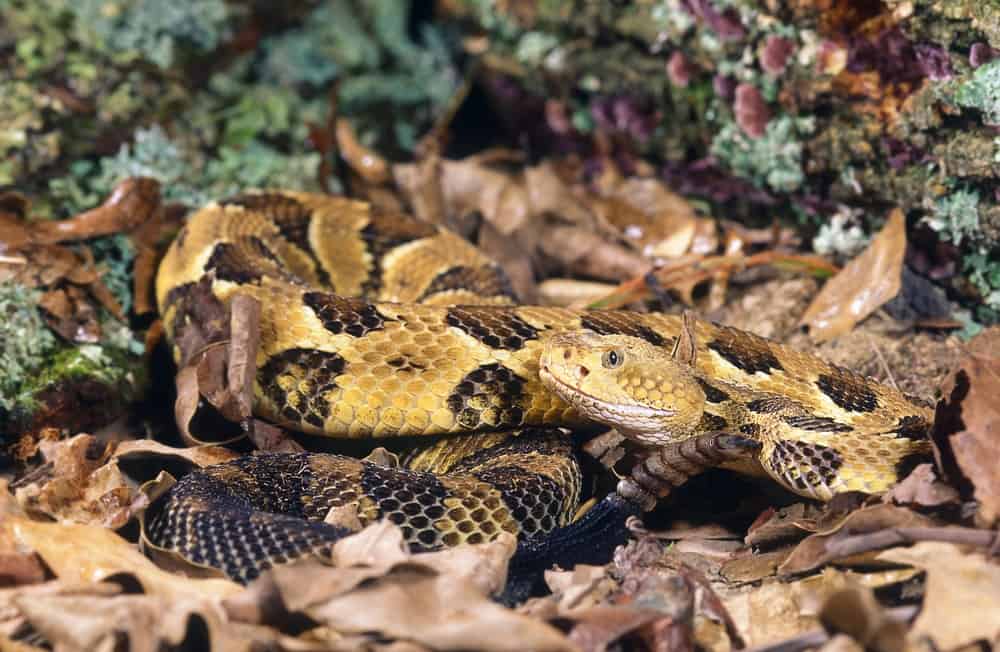
|
Scientific Name: |
Crotalus horridus |
|---|---|
|
Range: |
Throughout Tennessee |
|
Adult Size: |
Averages 30 to 60 inches |
|
Description: |
Large, robust snakes with broad heads and slit-shaped pupils Alternating dark brown and light brown blotches |
|
Habitat: |
Deciduous forests and other woodlands |
|
Venomous/Non-Venomous: |
Venomous |
Pygmy Rattlesnakes
Pygmy Rattlesnakes are the smallest pit vipers in Tennessee. Despite their small size, their bite can be lethal.
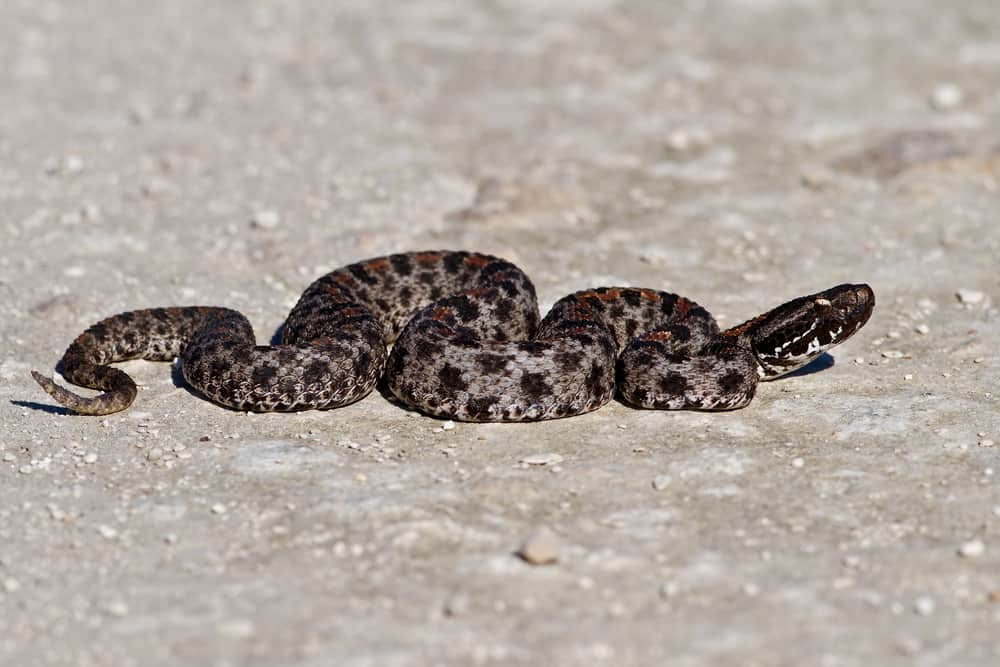
|
Scientific Name: |
Sistrurus miliarius |
|---|---|
|
Range: |
Western Tennessee |
|
Adult Size: |
Averages 16 to 24 inches |
|
Description: |
Relatively short, stocky snakes with vibrant chestnut brown, dark brown, or black blotches Typical shield-shaped head with slit-shaped pupils The last scales of the tail are adapted to form a “rattle” |
|
Habitat: |
Diverse: especially forests, flatlands, and sandhills |
|
Venomous/Non-Venomous: |
Venomous |
Eastern Copperhead – Agkistrodon contortrix
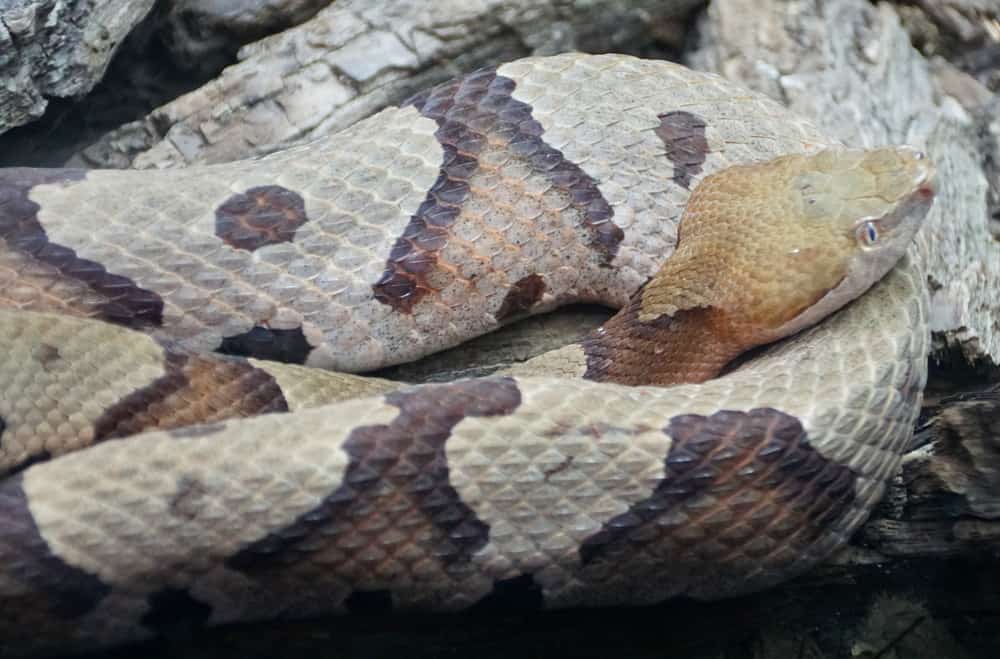
The Eastern Copperhead snake gets its name from its vibrant coppery color. These snakes are lethal and rely on camouflage for protection.
In some states, it may be easy to confuse this species with the Northern copperhead snake, but it doesn’t occur in Tennessee.
|
Scientific Name: |
Agkistrodon contortrix |
|---|---|
|
Range: |
Throughout Tennessee |
|
Adult Size: |
Averages 24 to 40 inches |
|
Description: |
Large, thick-bodied snakes with chestnut or dark brown markings on a tan or light gray background Copper-colored head with a shield-like shape and elliptical pupils |
|
Habitat: |
Rocky or hilly forests and woodlands |
|
Venomous/Non-Venomous: |
Venomous |
Northern Cottonmouth – Agkistrodon piscivorus
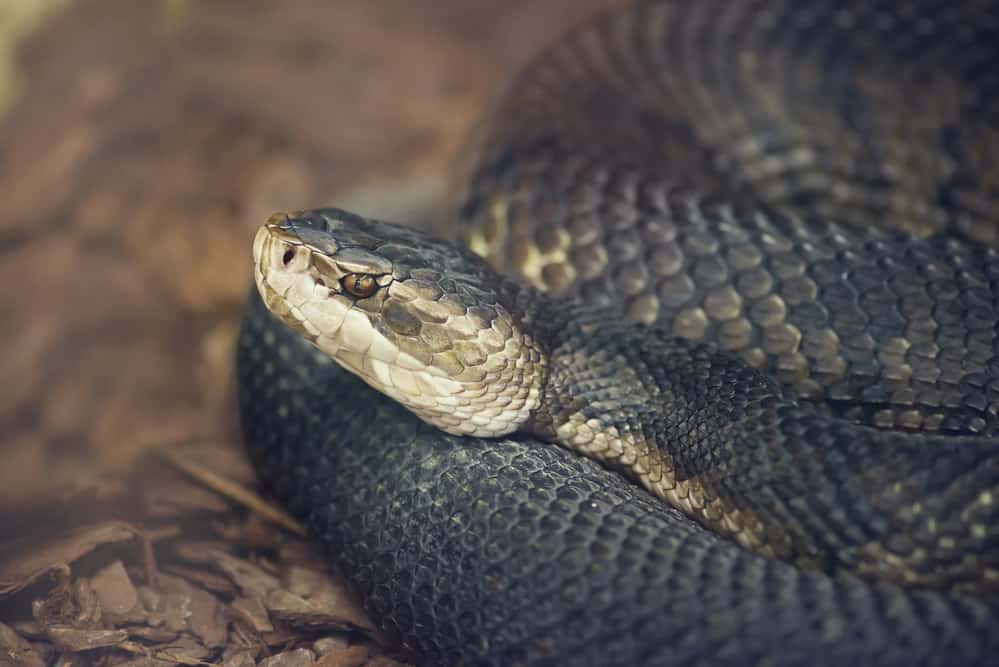
|
Scientific Name: |
Agkistrodon piscivorus |
|---|---|
|
Range: |
Western Tennessee |
|
Adult Size: |
Averages 26 to 74 inches |
|
Description: |
A stout-bodied snake colored dark grey or brown May have irregular blotches or markings Typical, broad pit viper head with elliptical pupils |
|
Habitat: |
Prefers habitats around freshwater, most common near swamps and marshes |
|
Venomous/Non-Venomous: |
Venomous |
Non-Venomous Snakes in Tennessee
There are many species of non-venomous snakes in Tennessee. Below, we’ll share about one or two of our favorite species.
Hognose Snakes
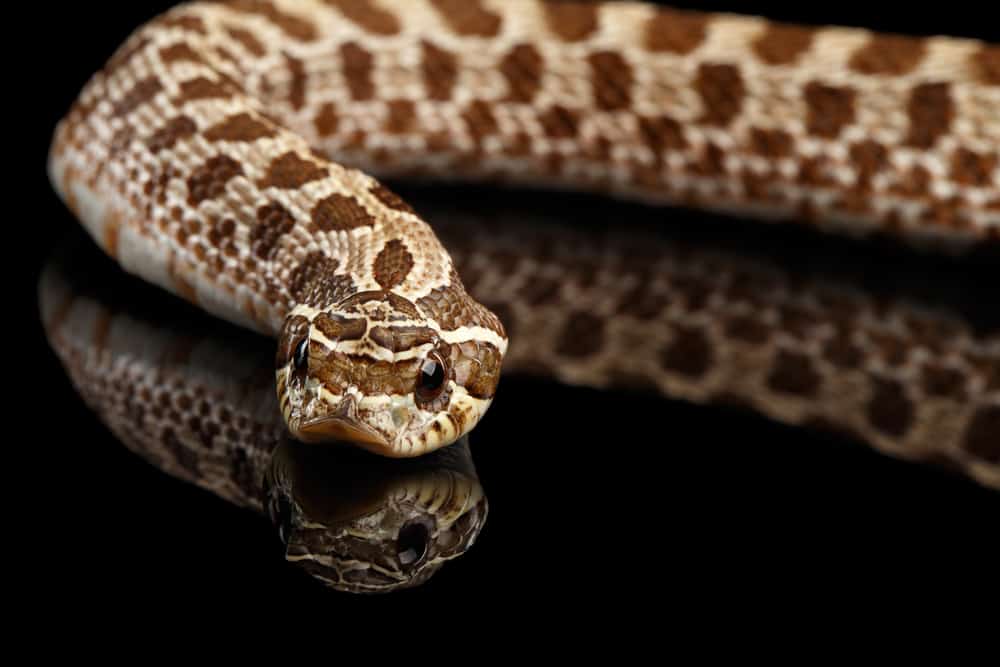
The hog-nosed snake is a harmless species with a snout that resembles the nose of a pig.
Hognose snakes, or hog-nosed snakes, can resemble pit vipers. However, the hog-nosed snake has a flattened nose and snout which sets it apart.
If you’re fortunate enough to see a hog-nosed snake, you’re unlikely to confuse it with another species.
|
Scientific Name: |
Heterodon platirhinos |
|---|---|
|
Range: |
Throughout Tennessee |
|
Adult Size: |
Averages 26 to 48 inches |
|
Description: |
Medium-sized snakes with a recurring pattern of dark brown spots on a tan background An upturned snout reminiscent of a pig’s nose, and large googly eyes |
|
Habitat: |
Any location with sandy or mixed sandy soils |
|
Venomous/Non-Venomous: |
Non-venomous |
Queen Snake
The queen snake or queensnake is a robust snake with a long thin tail.
They’re pretty distinctive, and you’re unlikely to confuse them for any other species in the region.
If anything, a water snake is the most likely candidate for confusion with these snakes.
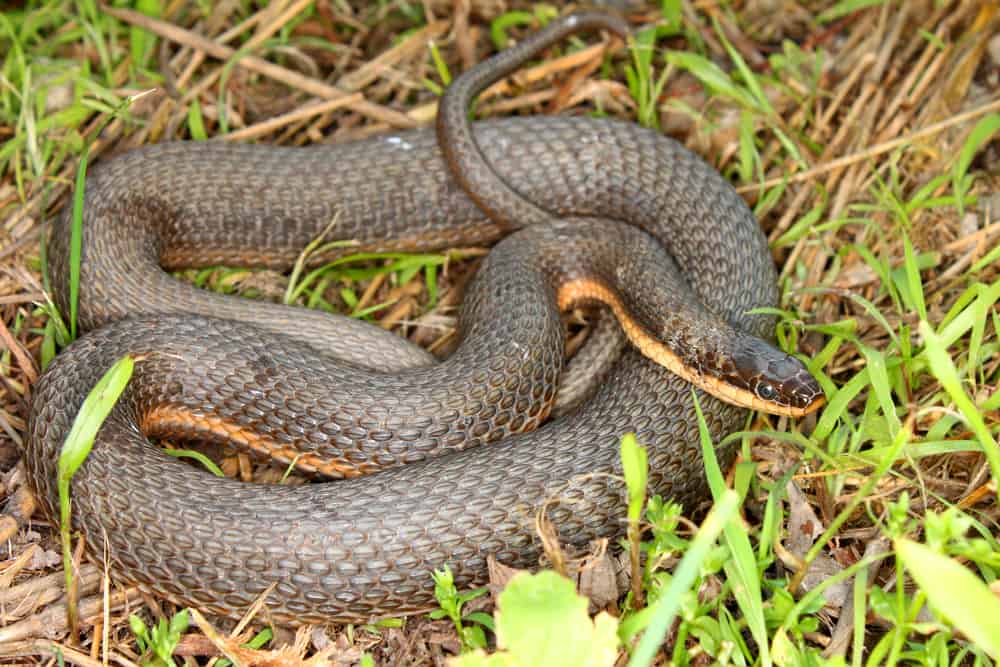
|
Scientific Name: |
Regina septemvittata |
|---|---|
|
Range: |
Central and East Tennessee |
|
Adult Size: |
Averages 15 to 24 inches |
|
Description: |
Long brown snakes with robust bodies The underside is invariably a lighter brown Rough scales, a long tail, and a slightly squared head with round pupils |
|
Habitat: |
Semi-aquatic; lives near rivers and other water sources |
|
Venomous/Non-Venomous: |
Non-venomous |
What You Need to Know
When dealing with Tennessee snakes, there are only a few essential things you need to know:
- Always watch from a safe distance
- Snakes don’t want to eat or chase you
- Snakes consider you a dangerous predator
- There are only four venomous species in the area
- NEVER try to catch, kill, move, or otherwise tease a snake
- Treat the snake with respect and it will treat you with respect
If you respect the snake and stick to these guidelines, you’re unlikely to have any problems.
Coexisting with Tennessee Snakes
As we mentioned above, the key to coexisting with snakes is to treat them with respect. The other key concept is to get over your fear of them.
Once you understand what snakes are, and how they live, you won’t fear them. This type of insight prepares you to handle any snakes you find.
About Venomous Snakes
All the venomous snakes in Tennessee are pit vipers, so they may behave differently from other snakes.
Rather than fleeing from danger, as most snakes do, pit vipers rely on camouflage to keep them safe.
As a result, it’s pretty easy to step on these snakes.
To make sure this doesn’t happen, you have to practice some safety actions. We’ll discuss them in the next section.
Treading Carefully in Snake Habitat
When walking in any place where you might meet a snake, vigilance is key.
Here’s how to keep safe in snake habitats:
- Wear sturdy shoes
- Stick to well-worn paths and trails
- Keep your pet on a leash at all times
- Use a hiking cane to help you assess every step if you need to walk in overgrown areas
If You Encounter a Snake
If you encounter a snake, there’s no need to do anything.
Unless it’s in a place where it might hurt someone, or get hurt, it’s best to leave the snake alone.
Of course, you can observe it from a safe distance, and even take photos from that distance.
However, you shouldn’t poke, prod, or otherwise bother the snake. If it needs to be relocated, contact a professional.
If you find a snake in your home, you should also contact an experienced wildlife handler.
When to Call for Help
There are only two instances when you’ll usually need to call for help:
- If a snake bites you
- If you need a snake relocated
Even if a harmless snake bites you, it’s a good idea to get medical attention. You may be allergic to the proteins in its saliva.
Unless a snake is in danger or poses danger to others, there’s usually no need for relocation.
If you need to have a snake removed, you’ll find the appropriate contact information in the resources below.
Useful Resources
We’ve compiled a list of resources that may be useful if you run into a snake.
Below you’ll find the information you need if you get bitten by a snake, need to relocate one or want to learn more about them.
Emergency Poisoning Advice
- ASPCA Poisoning Hotline: 1-888-426-4435
- Poison Control Center’s national hotline: 1-800-222-1222
Snake Relocation Services
- Free Snake Relocation Directory group on Facebook
- Tennessee Nuisance Wildlife Control Officers
Educational Resources
iNaturalist is an excellent resource for connecting with people who love snakes, getting identifications, or learning more about native species.
The Tennessee Wildlife Resources Center offers plenty of learning opportunities for anyone interested.
From watchable wildlife streams to fact sheets, the learning center offers plenty of valuable information.
We hope you’ve enjoyed this article about Tennessee snakes. Feel free to check out related content like our Wisconsin, Louisiana, Hawaii, South Carolina, Arizona, California, Pennsylvania, Texas, Florida, North Carolina, Alabama, Missouri, Georgia, Virginia, Michigan snake identification guides.
Which of the snakes in Tennessee is your favorite? Let us know in the comments.
